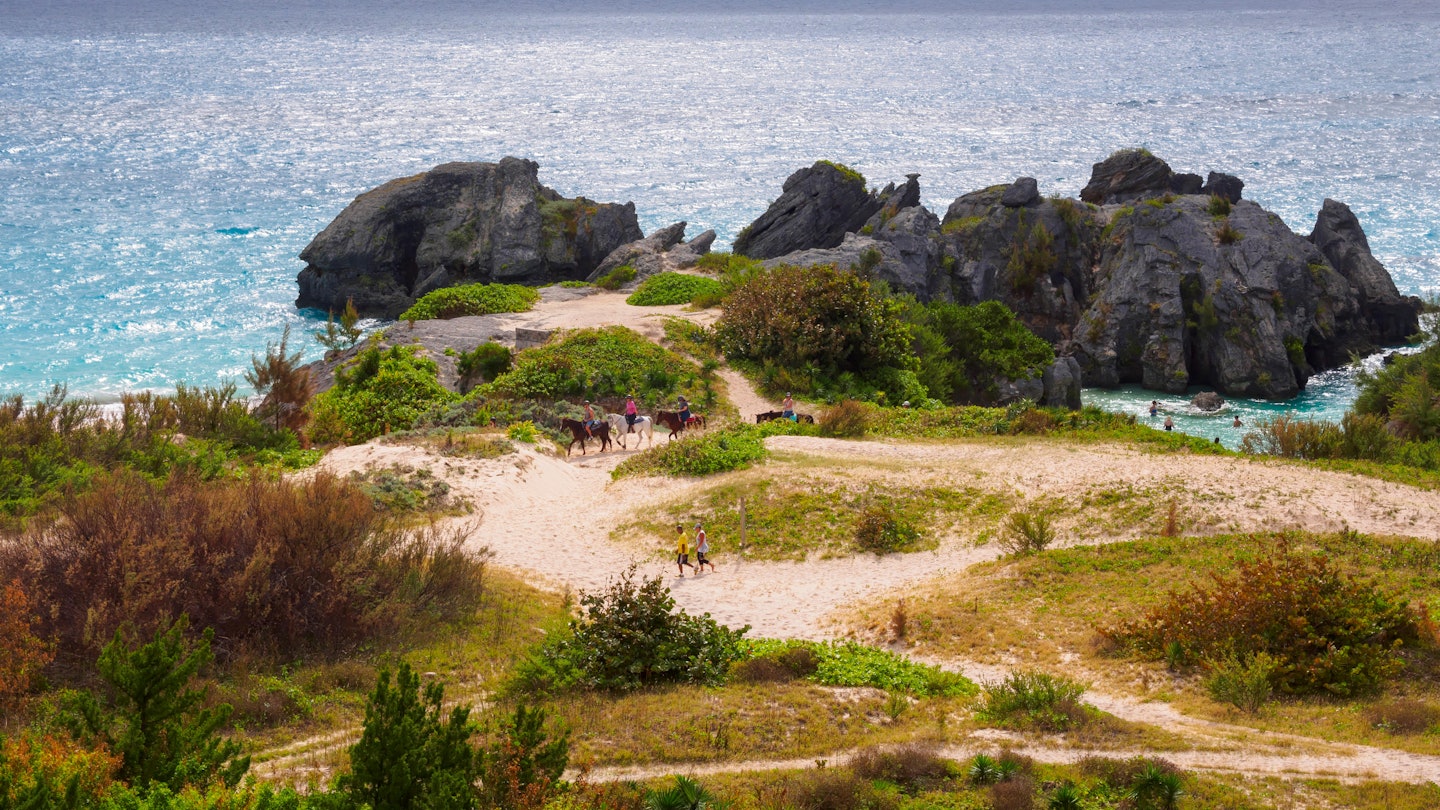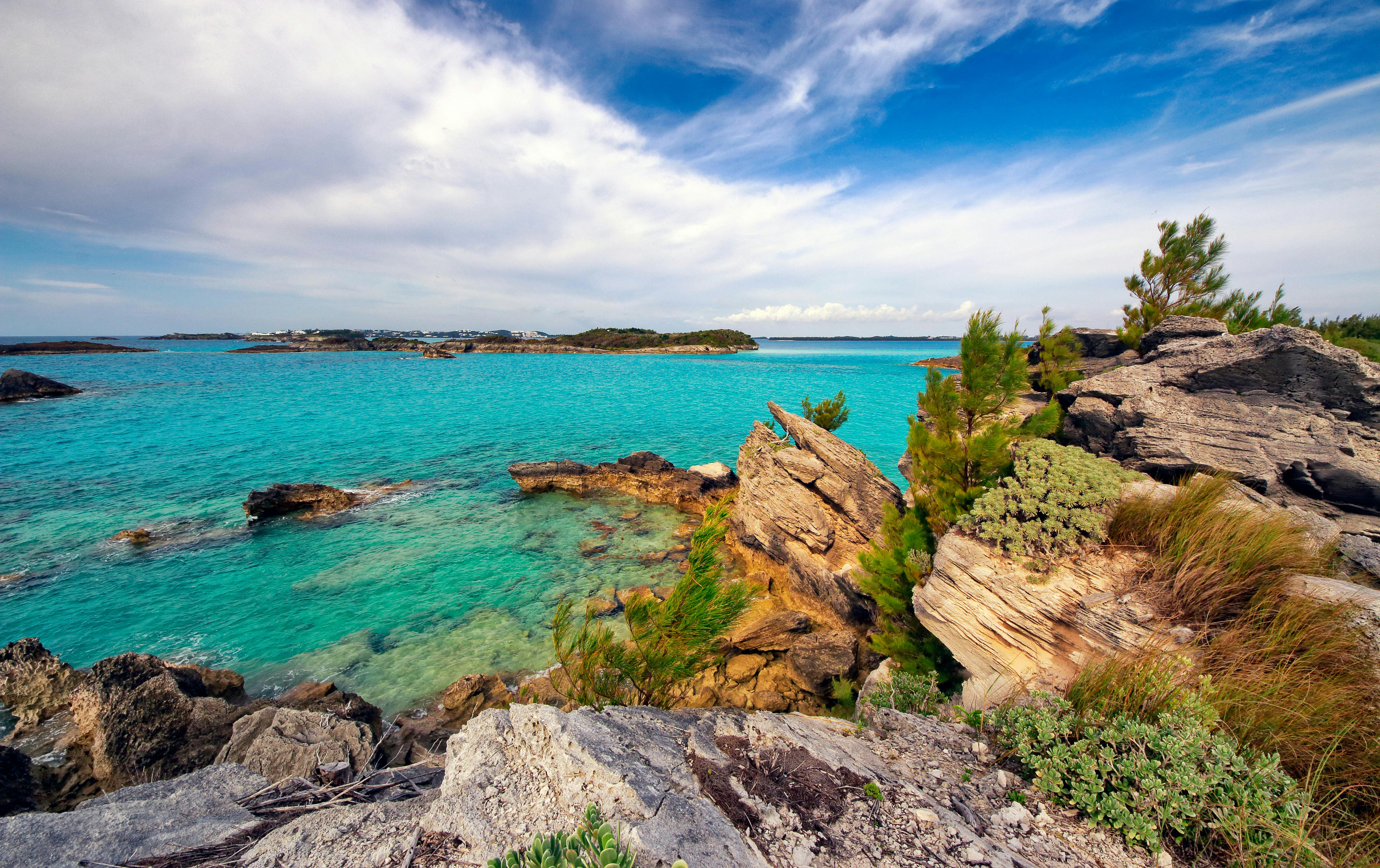

Take the moderate trail through South Shore Park to see some of Bermuda's best beaches © Louise Heusinkveld / Alamy Stock Photo
Bermuda might not be the first country that comes to mind when you think about hiking destinations. However, the beaches, cliffs, mangrove swamps and pockets of jungle in nature reserves that dot this 24-mile-long island in the middle of the Atlantic offer a surprising number of options for those keen to get exploring on their own two feet.
Leg-stretchers range from the moderately demanding Railway Trail that spans the length of the country to numerous trails crisscrossing Bermuda’s various nature reserves, giving you access to hidden caves and secluded coves.
For beginners there are easy jaunts that stretch along coastlines of powdery white sand, or scenic rambles that lead to centuries-old forts and lighthouses that stand sentinel, overlooking the ocean. These are the 7 best hikes in Bermuda.

1. The Railway Trail
Best hike for an overview of Bermuda
32km (20 miles), 1-2 days, one way, demanding
Spanning the length of Bermuda’s former railway that was dismantled in the 1950s, the Railway Trail is not just Bermuda’s longest and most demanding hike but also one that provides you with a wonderful introduction to the country’s hills, cliffs, beaches and diverse neighborhoods. It’s doable in one day if you’re a particularly hardcore walker, but if you’re short on time or just want to see the highlights, you can hop on the trail at numerous points around the island.
One of the most scenic sections takes you along the oceanfront, connecting Gibbet Bay in Hamilton Parish on the North Shore with the pretty white-sand beach in Whale Bone Bay in St George’s Parish. Take the bus to the North Shore Road & East Point Lane stop.
From the trail section bisecting some seafront parkland, you can contemplate the small, forested Gibbet Island, where once upon a time there used to be a gallows, where criminals and enslaved people that attempted to escape were hanged as a warning to others in the 17th and 18th centuries.
Continue along the rocky shore past Shelly Bay and emerge briefly along a stretch of the main road before picking up the Railway Trail again, opposite the Crawl Hill petrol station. A long stretch takes you along some wave-battered cliffs, through mangrove groves, past clear tidal pools and across pedestrian wooden bridges until you reach some picnic tables near Bailey Bridge.
From here, a series of recently refurbished bridges take you to Coney Island, with its appealing little pond, and then to the westernmost tip of St George’s, with fantastic views of Harrington Sound and Ferry Reach en route. A remote coastal section of the Railway Trail passes by a trio of 17th to 19th-century World Heritage Site forts inside Ferry Point National Park – Burnt Point Fort, Ferry Island Fort and Martello Tower – before reaching Whale Bone Bay.

2. Paget Marsh
Best birdwatching hike
300m (984ft), 20 min return, easy
Reachable by bus along South Road, this protected marshland is akin to Bermuda’s Jurassic Park: a glimpse into what the island looked like when settlers first set foot there (spoiler: it would have looked like an impenetrable woodland of palmetto, cedar woodland tangles of red mangrove and thickets of sawgrass-like Bermuda sedge, reminiscent of the Everglades).
A single, 150m-long (492ft) boardwalk juts out into the swampland, providing info on local flora and fauna. Endemic and migratory birds, such as warblers, kingfishers and herons, are often spotted here, along with giant toads – descendants of accidentally imported beasts from Guyana in the 19th century.

3. Bermuda Botanical Gardens
Best hike for flagrant blooms
300m-2km (0.1-1.2 miles), 15 minutes to two hours, easy
Easily reachable on foot from the Bermuda capital of Hamilton, strolling the hilly lawns of the botanical gardens is a wonderful way to acquaint yourself with endemic and non-native Bermudian flora. Look out for the fragrant 'sensory garden' on the west side of the gardens and Bermuda's famous cedars, which you may spot between Camden House and the South Shore Road gate.
Other highlights include the Double Fantasy freesia found along the beautiful flowering top lawns, which allegedly served as inspiration for John Lennon’s album of the same name. Created way back in 1898, there are 36 acres of gardens to explore here at your own pace.
4. Tom Moore’s Jungle
Best hike for caves and swimming holes
350m-2.6km (0.2-1.6 miles) round trip, 30 minutes to 2 hours, moderate
Overlooking Castle Harbour, this nature reserve is just down the road from the super popular Crystal and Fantasy Caves and just behind the venerable Tom Moore’s Tavern, but it feels a world away. Numerous tree-shaded rocky paths lead you through native palmetto and cedar woodland. Unless you’re here on the weekend, it’s a wonderful pocket of jungly tranquility where you can contemplate thickets of swamp vegetation and spot ample birdlife for whom these coastal mangroves and the central pond are home.
You can access the trailheads from the small parking area next to the west end of the Causeway and also from behind Tom Moore’s Tavern. Take a torch with you to explore Walsingham Cave, Causeway Cave and other subterranean attractions. From Tom Moore’s Tavern, it’s a 10-minute walk to Blue Hole, a former dolphin show lagoon fringed by mangroves, where you can join local daredevils in leaping into the cool, clear water from the 12-15ft cliffs.
5. Little Head Park & Great Head Park
Best hike for forts and coastline views
700m-1.5km (0.4-0.9 miles) one way, easy
The remote-ish Little Head Park that fringes a residential area is off the beaten track. Except for early morning walkers and runners, you’re likely to enjoy fantastic views of the Bermudian coastline with only wheeling longtails for company. Bermuda is a crucial nesting place for these iconic open ocean seabirds with distinctive tail feathers. Their arrival on the island in March heralds the start of spring, as far as the Bermudians are concerned.
Take the bus to the trailhead at the end of Cashew Road. From here, a footpath skirts the headland, with superb views of Gunner Bay, Paget Island with its Fort Cunningham remains, tiny Governor’s Island and Smith’s Island. You pass a sheltered cove as you meander along the Atlantic shore, and shortly the limestone ruins of Fort Popple come into view.
Built in the 1730s as a defensive fortification, climatic conditions have undermined Fort Popple's strategic position on Little Head with severe erosion caused by the Atlantic waves. It was then abandoned in favor of building a better-located fortification elsewhere in the parish to protect Bermuda’s eastern shores.
Atop Little Head, you can enjoy sweeping views of St David’s Head, Bermuda’s easternmost point, a little further out. It ends in precipitous cliffs with the outline of the doors to a WWII military bunker visible on the cliff face.
If you’re a WWII buff, you may wish to cross St David’s County Cricket Club grounds to the adjoining Great Head Park to check out St David’s Battery, completed in 1910, with guns overlooking the reefs. During both World Wars, ships arriving off the coast of Bermuda were met by the Royal Navy Examination Service and only then steered through the reef.

6. South Shore Park, Warwick Parish
Best hike for beaches
2.5km (1.5 miles) one way, one hour, moderate
Stretching along the south shore of almost the entire length of Warwick Parish, this trail allows you to take in a string of some of Bermuda’s loveliest beaches, so plan a lazy day and pack a bathing suit.
Starting from the car park off Horseshoe Bay Road, proceed to the cliffs at the north end of Horseshoe Bay Beach for a panoramic view of this wide crescent of pristine white sand, lapped at by cerulean waters. The best time to come is early morning when there’s a rosy sheen to the sand, and the cruise ship crowds haven’t yet arrived.
Proceed east along a network of narrow, sandy footpaths through the dunes to reach Stonehole and Chaplin Bay – twin coves bookended by limestone cliffs whose sheltered waters offer decent swimming and snorkeling. A little further along the main footpath, you’ll come across Jobson’s Cove, a stunning swimming hole framed by a horseshoe of jagged cliffs. Not long after, you reach the half-mile-long Warwick Long Bay – a narrow stretch of pink sand, typical of Bermuda with its shallow, calm waters, making it popular with families.

7. Cooper’s Island Nature Reserve
Best for turtle and crab spotting
400m-2km (0.2-1.2 miles) one way, easy
Until 1995, Cooper’s Island was a U.S. military base and then a NASA tracking station, but now this parkland is very much open to the public and ideal for a relaxed day of hiking, picnicking, swimming and wildlife spotting.
An extensive network of walking trails (from 200m to 2km) crisscross this quiet protected area at the southeastern tip of Bermuda, meandering through mixed woodland of the last of Bermuda cedars and olivewoods along with Brazilian pepper and allspice.
The reserve is fringed by seven beaches: Clearwater Beach, Long Bay Beach and Turtle Bay Beach are a favorite with locals, while quiet Well Bay Beach and the coves near the tip of the peninsula are frequently deserted. If you’re lucky, you may spot green turtles and hawksbill turtles while snorkeling offshore.
Pack your binoculars if you’re a birdwatcher – the salt marsh is an important habitat for kingfishers, egrets, and herons, along with giant land crabs.











